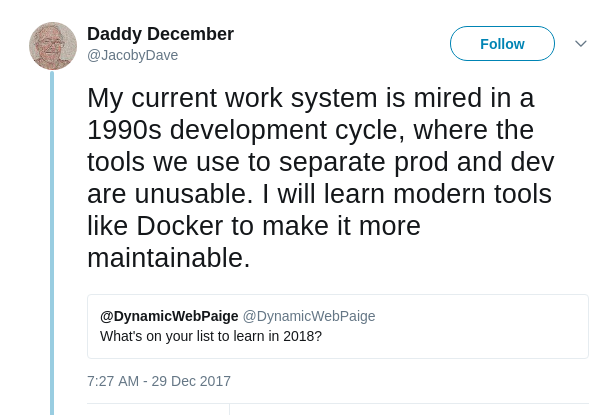The Storm
Eppy.
Certified AWS Cloud Architect, Professional; an Operations Engineer.
Eppy.
The Great Contraction.
“Back when WordPress was released in 2003, the competition was unconvincing. However, this was 15 years ago.”
The great contraction. So much power, used to? Do what exactly?
The transition is to thin services. Thin formats, with fast delivery. Irony at it’s most regular.
We can give them a couple of more years to solve the problems from 2014!
https://www.hashicorp.com/blog/announcing-terraform-0-1-2-beta1
Initial release July 28, 2014; 4.5 years ago
beta
Honestly Terraform should be deleted. On the Wiki it says “See also: Ansible.”
Also movable type.
Sometimes systems administrators need to perform some ‘alternative’ tasks that require some ‘temporary’ workspaces.
Does one have a space machine? Sometimes, but not always.
Well, Vagrant + Virtualbox + fso/xenial64-desktop will give you just that.
Virtualbox supports displaying the VM in Virtualbox, so, once the image is ‘vagrant init fso/xenial64-desktop and vagrant up` you will have a clean, new Desktop to do.
In this case, I helped a junior admin migration some email to Office 365 email. We created an encrypted backup after the migration, then destroyed the intermediate machine.
Pulseaudio allows for one-click to stream audio over a network to another machine running PulseAudio. Pair that with a Raspberry Pi, and you have a network audio receiver, and a wired network, for turn-key, remote network audio streaming.
https://www.freedesktop.org/wiki/Software/PulseAudio/
Xfce is great full time, but full-time VLC in your audio control is not. Info how to remove it with dconf here:
https://askubuntu.com/questions/468811/remove-vlc-player-from-sound-menu-in-unity-bar
DCONF edit -> com.canonical.indicator.sound interested-media-players -> Default, remove vlc.desktop
If the mainframe evolved into desktops, isn’t web hosted email a re-centralization of what already was not?
If the mainframe didn’t evolve into desktops, then computing would be centralized.
So, are things re-centralizationing? Comment below and discuss. Email me if you understand the Easter egg.
Simply put, AWS is adopted by a company, not the IT department. DevOps, CI, Cloud… all for business. The depth of the cultural adoption will vary, and, will shape the company in a positive direction.
I wouldn’t argue with him though. Middle-ware is necessary but not sufficient for an application stack.
It was also born in a time that lacked the maturity of other platforms, in my opinion the ability to provision resources dynamically.
It can be called cloud, or software-defined, or whatever one chooses.
Introducing another layer of complexity into the stack doesn’t solve the original problem.
Everything-as-code practice and general purpose languages are of great importance in the time of….
The real purposes of this post
I propose terming this time period of computing general ubiquity (GU?).
We see technologies are generally ‘stable.’ They are in a period of contraction (evidenced above).
Core technologies aren’t on the brink on the foreseeable limits. Most scale problems are solved but horizontal/parallel use of (now) the technologies that (were) developed in the previous time of non-GU.
The drive for cost is pruning the tech-tree.
The time period of general ubiquity (GU?) is marked by: contraction, parallelization, and stability (QoS, performance, costs). The GU period is marked by the introduction of some ‘game changing’ technologies. These game-changers are major leaps usually found and discussed in the non-mainstream. The periods during their introduction are marked by resistance, push against (throwing shade), or downright emotional response. This occurred around 2005 and then in 2012.
Evidence is the link above. This would have been lambasted by technocrats ~2-4 years ago, because those who supported it were in the lenses of the previous period of non-ubiquity. So they were mentally-vulnerable to a shiny object.
GU- versus non-GU.
Find the markers.
Back to the link
In 2012, I was trying to figure out how development environments could be more portable.
Yeah, exactly. Everyone else was struggling with everything else the same way. Not limited to just portable, but re-usability, and consistency across everything.
issues with SV and HR
No comment on this one.
The sudden change
Non-GU.
The real problem with Docker is a lack of coherent leadership.
This isn’t the first time a failure of leadership has been documented to cause a fall.
the brand’s cool factor that fueled its wild success.
Bubble.
It is said that, “Great civilizations are not murdered. They commit suicide.”
Respect, learn, study, respect more, then build upon, in that order, the lessons of the past.
Find the markers.

The 90’s was also a non-GU period. BBS’s and 56k protocols were still in flux back then.
UPDATE: This link here, they GET IT. https://outrunchange.com/2011/11/05/the-computing-pendulum-has-swung-back-to-dumb-terminals-and-service-bureaus-%E2%80%93-will-it-swing-back/
Ansible can do anything. The pattern of idempotent state modelling is powerful.
I expect some shakeups, and some clashes over technologies in this area…
Web server outputting what you expect, plus some extra?
Check your configs for your web application, make sure it’s clean. That’s what happened to me.
Also, look at this guy’s post:
I can relate, been there. Customer didn’t have any configuration management, and always had random characters appended to web server output, or images. Random, meaning, what someone manually put in there.
Automate is great.
Wow, this is amazing. Alt-Drag.
Great for faster window management, for Windows.